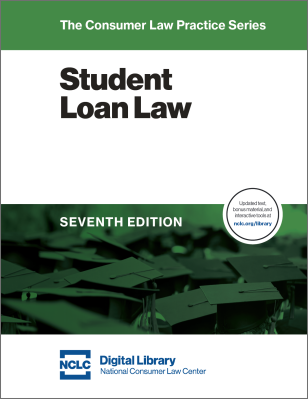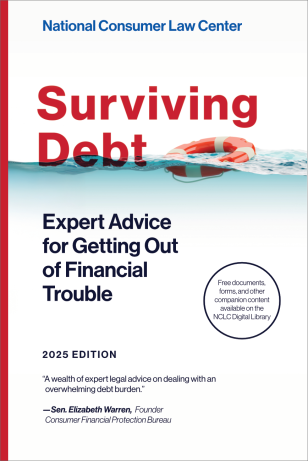NCLC has just released a new Student Loan Toolkit (May 2024), a free online resource and an essential aid in advising student loan borrowers nationwide. Borrowers themselves can also profit from using the toolkit. Download the 52-page toolkit and feel free to disseminate it widely. The toolkit will be updated over time, so it pays to return periodically to nclc.org/resources/student-loan-toolkit to download the most recent version.
The Student Loan Toolkit is organized in two parts. Part 1 explains the basics of the student loan system, how to assess a borrower’s unique student loan situation, and options for managing student loan debt. The toolkit’s highlight is a checklist/practice aid found in the toolkit’s Part 2.
Checklist and Client Questionnaire Found in Part 2
The second part of the toolkit is a unique set of checklists and practice aids that can be used to guide meetings with borrowers, collect key information, and document information for the borrower to refer to as needed.
As a client questionnaire, the checklists and guides found in Part 2 proceed step-by-step to ascertain key information needed to evaluate most student loan borrowers’ best options. In addition, the checklists and guides provide flags for key programs and benefits a borrower may be eligible for as they go through the checklist and complete the questions. Importantly, each checklist is linked to Part 1 of the toolkit, where borrowers and advocates can find more information on that specific topic.
The links back to Toolkit Part 1 provide clear instructions for how borrowers on their own can find the information to complete each checklist and guide. If the borrower has access to their student loan information, the borrower could complete the checklist before meeting with an attorney or other advisor, allowing for more time to be spent during a client meeting to develop a plan for managing their student loan debt. Attorneys and advisors can also help borrowers complete the checklists during their initial intake meetings. The checklist is a fillable pdf file, so it can be completed digitally or it can be printed out and completed by hand.
The checklists and guides found in Part 2 of the toolkit are packed with helpful features, such as:
- Identifying the borrower’s basic loan information: Does the borrower have federal or private loans, or both? What type of federal student loans does the borrower have? Is the borrower seeking help for their own loans, loans they took out for their children, or loans they co-signed? Who holds the borrower’s loans? Who is the loan servicer? Does the borrower have access to their account on studentaid.gov?
- Determining the borrower’s repayment status: Does the borrower want to pay off loans quickly or want to earn credit toward loan cancellation? Is the borrower struggling to afford payments? What is the status of the borrower’s loans currently? Are the loans in a grace period, deferment, or forbearance? Are the loans delinquent or in default? Which payment options would work best given the borrower’s goals and resources?
- Is the borrower eligible for loan discharge, forgiveness, or cancellation: The checklists and guides in Toolkit Part 2 set out the basic eligibility requirements for the most common federal student loan cancellation and forgiveness programs, including Total and Permanent Disability Discharge, Public Service Loan Forgiveness, Income-Driven Repayment (IDR) loan cancellation, Borrower Defense to Repayment Discharge, False Certification Discharge, and Closed School Discharge.
- An Income-Driven Repayment Plan Comparison Chart: Part 2 of the toolkit includes a unique comparison chart for each the different repayment plans (SAVE, PAYE, IBR and ICR). The chart lists which federal loans are eligible for each repayment plan, how payments are calculated, and how long payments must be made to achieve forgiveness under each plan.
- A guide for when to potentially consider loan consolidation and bankruptcy: Part 2 of the toolkit also includes fillable guides to help identify when a borrower should possibly consider consolidating federal student loans into a new federal Direct Loan or file for bankruptcy.
- Identifying a private student loan’s status: The guides and checklist include questions to review the different possible repayment and collection statuses for a private student loan so that the appropriate next steps can be identified.
Toolkit Part 1 Provides Detail About Student Loan Rights and Options
The toolkit’s Part 1 comprehensively covers the basics concerning student loan borrower rights and options:
- Identifying the types of loans at issue, including the differences between federal loans and private loans, as well as the differences in the many federal student loan programs.
- Lowering payments through income-driven repayment plans, and determining which plan is right for a specific borrower.
- The various ways to receive cancellation, forgiveness, or discharge of federal student loans.
- Getting loans out of default and stopping collection, including signing up for a “Fresh Start” that automatically eliminates default and stops collection.
- Defenses to obligations on private student loans, including the statute of limitations and several relief options.
- Why borrowers should not refinance federal student loans with private student loans.
- Student loan scams to watch out for.
- Organizations that can help with student loan problems.
Special Note About California Resources
NCLC created the Toolkit as part of the Student Loan Empowerment Network (SLE Network) launched in June 2024, by the California Department of Financial Protection and Innovation (DFPI). The SLE Network includes community-based and legal aid organizations that will provide free assistance to Californians struggling to understand and pay off their student loan debts. While the toolkit was produced with the support of the California DFPI, the free toolkit is designed to be used nationwide.
Additional Resources
NCLC’s Student Loan Law (7th ed. 2023) (888 pages) is the leading treatise on all aspects of student loan borrowers’ rights and options. It is available as a digital subscription or as a print and digital subscription. The digital version allows for rapid publication of new developments, powerful searches, links within the book and to other NCLC treatises, and includes additional bonus materials, including pleadings and practice tools. For attorneys and others with a practice that includes representation or advice for student loan borrowers, this is an essential, in-depth resource.
NCLC’s Student Loan Borrower Assistance website is designed to provide all the basic information and the latest news for student loan borrowers and for their advocates. The website also includes help videos, a blog, and links to other resources. You can also sign up on the site at Student Loan Borrower News to receive emails with the latest developments.
Surviving Debt is NCLC’s most popular book. The digital version is now free on the NCLC Digital Library or order here the 2024 print edition (344 pp.) ($20 incl. shipping). Surviving Debt Chapter 13 is the best general overview covering key rights, options, and risks facing student loan borrowers.
The book in its other 25 chapters contains hard-hitting advice from the nation’s consumer law experts on how to deal with other crushing debt affecting millions of Americans: responding to debt collectors, the truth about credit reporting, medical and credit card debt, repossessions, evictions, utility terminations, defending the home from foreclosure, when to file bankruptcy, and much more. View the table of contents here.



